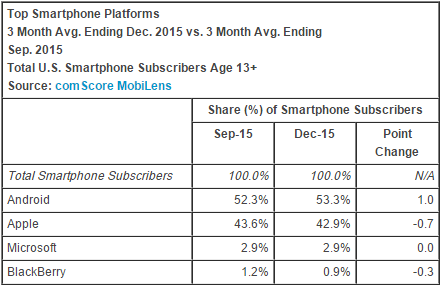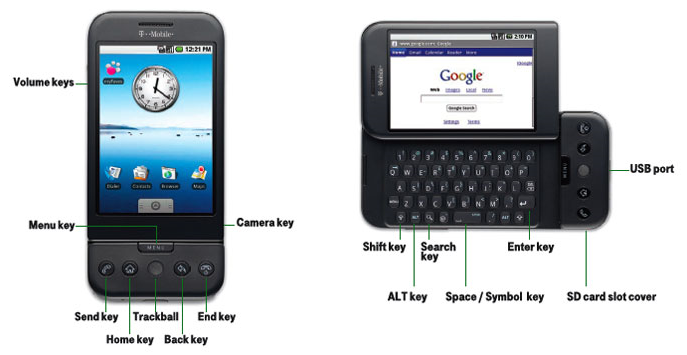There is no doubt that Microsoft is a tech super power in this game of smart phone wars, but Google’s Android and Apple’s iOS have challenged them to date. As per Fig. 1. Microsoft’s phone OS (operating system) market share has stayed about steady at about 2.9%. Blackberry on the other hand has so little market share they are hardly worth mentioning since their mobile phone OS market share has dropped to .09% at the end of 2015 (Fig 1.). Although different phone OS market research reports have slight up or down variations, the point is that Microsoft and Blackberry are hugely losing the Smart Phone Wars.
Fig. 1.
 Last time Cassem and I commentated on this situation was August of last year when Microsoft was high on the release of Windows 10, arguably their best operating system in a decade but not without risk. In our last piece we valued many aspects of Microsoft’s products including the Cloud, SharePoint, and Windows 10 for business users, but we only began to address the full story. Yet our prior conclusion that Microsoft as a company is undervalued is unchanged because they have so many successful products including Server, Exchange, Visual Studio, System Center, Dynamics, and SharePoint, in spite of their phones weaknesses.
Last time Cassem and I commentated on this situation was August of last year when Microsoft was high on the release of Windows 10, arguably their best operating system in a decade but not without risk. In our last piece we valued many aspects of Microsoft’s products including the Cloud, SharePoint, and Windows 10 for business users, but we only began to address the full story. Yet our prior conclusion that Microsoft as a company is undervalued is unchanged because they have so many successful products including Server, Exchange, Visual Studio, System Center, Dynamics, and SharePoint, in spite of their phones weaknesses.
In this post we will specifically explore why Microsoft is losing the smart phone war and what can be done about it so they can win. First of all, Microsoft was late to the game in October 2010 with the release of the Windows Phone 7. Google was early with the T-Mobile G released in October 2008. (Fig. 2.). Apple was the first with the iPhone 1 released in June 2007. Microsoft’s late entrance in conjunction with their delay to take phone apps seriously has proven to push app makers to the dominate platforms, Android and iOS.
Mobile applications are increasingly addictive for phone users and since the Windows platform has so few that means most mobile gamers, media streamers, and multitaskers will avoid the Windows Phone in the immediate future. Most corporate mobile phone contracts favor the iPhone and those contracts will take years to be undone to the detriment of Microsoft.
Fig. 2.
 With 53.3% (Fig. 1.) of the phone OS market share there are a few things that Android got right. The integration of Google Calendar is easy, useful, and free. Conversely, on a Windows phone, the integration of Microsoft Outlook is awkward, overly optimized for a traditional PC, and it’s not free for the full version. As an owner of many Android phones I can see how the many OS updates have proved to make the platform much better with more efficiency and less bugs, especially on the Lollipop release of Android.
With 53.3% (Fig. 1.) of the phone OS market share there are a few things that Android got right. The integration of Google Calendar is easy, useful, and free. Conversely, on a Windows phone, the integration of Microsoft Outlook is awkward, overly optimized for a traditional PC, and it’s not free for the full version. As an owner of many Android phones I can see how the many OS updates have proved to make the platform much better with more efficiency and less bugs, especially on the Lollipop release of Android.
Apple comes in second with 42.9% of the mobile OS market share (Fig. 1) because they have gotten a lot of things right. Apple’s OS works well together and is recognized as artful by the majority of the creative community — their early integration of iTunes and the iPod into the iPhone made it a big hit. Also, you can use the iPhone with Apple TV, an iMac, iCloud, the Apple Watch, and Airport Time Capsule, to name a few. ITunes has been a force to deal with but has started to lose market share in recent years as streaming services and other digital music services have come on board, specifically Pandora and Google Play. Android users will say iPhones are overly simplistic, but to those users, that is a benefit. There are a lot more settings options in Android, but Apple fans feel they don’t need all those features. This is one ongoing battle between iOS and Android.
Security varies greatly in each of the platforms. Apple has a very secure and closed off OS and network and they rarely share info with other tech companies. Apple’s app network is also massive and thus they have experience with a lot of different architectural frameworks and they are good at approving and declining apps based on security. Unlike Apple, Android has had some issues with fake apps designed to compromise security that were available for download in the app store. Additionally, in recent weeks Apple has taken a respected but partially controversial stance to protect its user’s privacy in the wake of what many argue is an overreaching government. (In Debate Over Apple-FBI Dispute, Gates And Zuckerberg Don’t Agree). This is a public debate that needs to continue and unfortunately as of now, Microsoft has given a more a-political and lukewarm response to this debate – though Microsoft founder Bill Gates disagrees with full privacy coverage arguments.
Windows 10 appears to be a pretty solid platform that builds off of some security benefits of Microsoft’s enterprise systems. Windows 10’s Credential Guard protects corporate identities by isolating them in a hardware-based virtual environment. Device Guard depends on Windows 10’s virtualization-based security to allow only trusted applications to run on devices — letting the service use signatures defined by your enterprise-controlled policy (Tech Net Device Guard Overview). In our mind, Microsoft needed to do this to help leverage its legacy network of enterprises that could upgrade to the new Windows 10 OS in the most secure way including Server, Exchange, Visual Studio, System Center, Dynamics, and SharePoint.
Moving on, iPad and Android based tablet customers have been frustrated with the slow speed and low power and functionality of these devices for a long time. In response to this Microsoft has been an innovator and leader with the design and release of the Microsoft Surface. The Surface redefines what a tablet can be. It brings full computer power, something that had not been done on a tablet in the past. As the Surface improved up to its latest iteration, the Pro 4, it proved to validate the clever Windows 10 OS. As of January 28th 2016 Surface sales are up 29% from last year (2015) (Microsoft Q2 2016 Earnings Report) which suggests that with the right improvements they could also get considerable gains in the phone market.
Why would someone change to a Windows Phone? First off, there are a lot of users out there that are familiar with Windows in general. “For example, Skype has been downloaded more than 900 million times on iOS and Android devices, Microsoft CEO Satya Nadella said during a recent earnings call” (Microsoft Q2 2016 Earnings Report). The only problem in most people’s minds is that they use their phone differently than they use their PC. Microsoft has to convince these people that there are similarities, cross-usage benefits, and that the user experience is better or good. From a user experience standpoint, Windows Hello is a great feature that provides for facial recognition log in and Cortana is the virtual assistant that is controlled by voice recognition (Fig. 3.). Positively, Office Mobile comes with all Windows 10 phones and that includes a great iteration of PowerPoint with a fun and easy to use interface (see video below). Moreover, all Windows 10 phones can connect to Blue Tooth keyboards, mice, and dual monitors. Granted, the mobile version doesn’t have a desktop built in like the PC version does but it has something better for the mobile environment, Continuum. Continuum turns your phone into a big-screen projector and a big-time productivity tool when you have the Microsoft Display Dock as described in the video below.
Fig. 3.
The new Windows 10 is a much more connected OS than previous OSs. It seems that part of Microsoft’s strategy is connecting the new OS with their cloud business over time. The Windows 10 Phone gives a lot of connected apps that show new emails, current weather, and news just by glancing at the home screen. In the iPhone, the icons will rarely show updates. The only iPhone app that comes with the phone that shows updates is the calendar app. This is an idea that is built into Windows 10 giving people the convenience of not actually having to open the app to get the information they are quickly looking for. If they want more information, they can open the app and go from there. Lastly, the criticism of Nokia as a phone company is exaggerated. It is a good thing for a hardware and software company like Microsoft to own a phone maker and although not all Lumia models have been hits they have a positive trajectory. This trajectory is due to enhancements including a great camera, crystal clear screen, a removable battery, Windows Hello, Office Mobile, and most of all its ability to transform into a desktop computer via Continuum.
Jeremy Swenson and Mike Cassem are two seasoned, Intel certified, retail technology marketing and training representatives on assignment at Best Buy for clients including Intel, Trend Micro, Adobe, and others. Swenson doubles as a Sr. business analyst and project management consultant while Cassem doubles as a Marketer and Sales Consultant. Tweet to them @jer_Swenson and @micassem.


